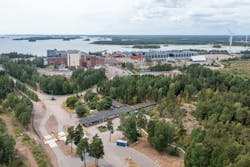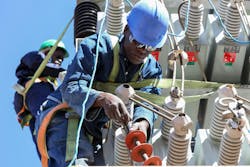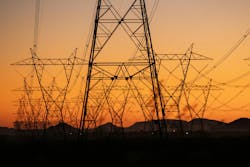Key Highlights
- AI and data centers are contributing to unprecedented growth in electricity demand, which may outpace current infrastructure capacity.
- Forecasting demand is increasingly uncertain due to rapid growth and construction delays, complicating resource planning for utilities.
- Big Tech companies are becoming more involved in power infrastructure, often making long-term commitments to secure energy supply.
- Utilities face significant capital expenditures and need to develop new transmission and generation capacity to support data center growth.
- Close collaboration between data centers and utilities is essential for coordinated planning and sustainable expansion.
Artificial intelligence is touted as the answer for every inefficiency in business, every work- or life-related headache, and the friend to every parent who can’t think of what to do with the two pounds of boneless chicken breasts they thawed out earlier in the day. The technology is supposed to also make an absolute ton of money. So far, it appears to be costing a lot of money. But here in the electricity realm, the big question with AI seems to be how quickly is Big Tech going to need all those data centers they are planning on building, and how are they going to power them?
Electricity peak demand and energy growth forecasts over the 10-year assessment period continue to climb higher than at any point in the past two decades, according to the North American Electric Reliability Corporation’s (NERC) 2024 Long-Term Reliability Assessment. The energy demand picture, in short, has been rather boring for the past few decades. Now, business is starting to pick up, leading some in the industry to wonder how quickly things can pivot.
Growing large commercial and industrial loads, electrification of household appliances and increasing electric vehicle adoption are all major factors here — and they may outpace the data centers in the long run. However, a small but growing slice of the pie is represented by the emerging large load of data centers, particularly those involved with cryptocurrency mining and artificial intelligence. These, according to NERC, present challenges to forecasting and planning for increased demand.
“The overall speed and magnitude of the growth in and of itself is causing strain on the existing resources. But there’s this additional component, which is the uncertainty of forecasting the demand growth and how it affects your assessments and the certainty of your demand forecasts,” said Evan Mickelson, Power Systems Modeling and Analysis Engineer at NERC.
In a July 24, 2025 webinar, Mickelson drew from a NERC report titled “Characteristics and Risks of Emerging Large Loads,” saying the speed and volatility of these large loads coming online can exhaust reserve margins.
“When utilities have a large interconnection queue for their really large loads, they have to assume that some of them aren’t going to materialize. The assumptions there are really, really important. The increased uncertainty is one of the big drivers of the risks to your resource adequacy,” he said.
Shared Goals, Different Timelines
Big Tech and the power grid share a similar problem: if either the internet or the electricity get knocked down, people start complaining quickly. Both need to maintain reliable, uninterrupted service around the clock. However, things tend to move a lot more quickly in Silicon Valley than they ever do for people who maintain the power grid.
“The scale and speed with which the tech industry operates is on a different time spectrum than the electricity ecosystem. And so, what we're faced with is what I like to call a growing pain between where our tech companies need to be to serve our customers and to serve this demand and what we're really capable of doing as an electric industry,” Briana Kobor, Head of Energy Market Innovation at Google, said in a June 18, 2025 EPRI Current podcast episode posted by the Electric Power Research Institute.
Kobor identified aging infrastructure, the need to build increased long-haul transmission and clogged power generation queues as issues hyperscalers such as Google need those who operate in the power sector to solve, adding that collaboration between Big Tech and power engineers needs to be paramount.
“We are seeing scaled increase in demand from data centers and other parts of the industry,” Kobor said, adding that data centers and the products that they deliver to people have become central to people’s personal lives and businesses. “I like to think of data centers as the backbone of our modern economy.”
A Growing Energy Hunger
An EPRI study found that data centers could consume up to 9% of US power generation by 2030 — more than double the amount currently used.
Data centers are already having issues securing enough power generation to meet their growing demands. Load growth from data centers is placing strain on regional power grids and more than 100 GW of new data center projects could come online over the next decade in the U.S., said James Russell, a principal in Charles River Associates’ Energy Practice.
“Any system headroom that was available prior to 2023 is likely allocated to new projects – meaning that each incremental MW of load requires an incremental MW of generation and transmission capacity,” Russell said. “Years-long load queues are present in most Tier 1 data center markets with adjacent markets becoming congested as well. Utilities and independent system operators (ISOs) need to ensure a permissible rate of load growth that can be matched by new grid infrastructure such that new load doesn’t infringe on system reliability and affordability.”
The limits that exist on how many power plants and power lines can be available in a particular area is already imposing a limit on the growth of AI and the data centers that fuel it, he said.
“The limiting factor for most data center projects is the ability to secure interconnection and power supply. Cumulative load queues across the country currently exceed 400 GW with U.S. peak electricity demand around 760 GW – this scale of load growth is driving delays across all aspects of supporting supply chains,” he said.
Underscoring the disconnect in time scale between the two industries, a 500 MW data center can be up and running in 1-3 years, while the transmission and generation infrastructure it would need to function could take 5-10 years, or perhaps longer.
Big Tech: A New Power Partner?
In response to this mismatch, Big Tech is getting more involved in the power sector, and that involvement may deepen in the future.
When asked if we might get to a point where tech companies take more of an interest in power grid infrastructure and maybe even invest in it, Matt DeCourcey, vice president in Charles River Associates’ Energy Practice, said we are already there.
“In most cases, connecting a new data center now requires new generation or transmission capacity to be built specifically to serve that load. The mechanics vary: some are structured through PPAs, others through service contracts with minimum-take provisions, and in some cases through direct ownership. But the principle is the same: the data center is making a long-term, binding financial commitment to cover the cost of the resource and the infrastructure needed to deliver it,” DeCourcey said.
This leaves planners and regulators with two options: Do they wait to determine how much G&T resources will be needed for a particular data center project before one is allowed to connect, or do they let data centers connect while requiring that they be interruptible. The former method is favored in Nevada, Arizona and other states. The latter is being applied in Texas, Utah and elsewhere, DeCourcey said.
Tony Tewlis, Senior Vice President of T&D Operations for Arizona Public Service (APS), said during T&D World Live 2025 that dealing with the power demand from data centers was among his top challenges.
“With data centers and Big Tech, meter sets are now much larger. 500 MW is the average size of the request for one of these customers, which is comparable in size to a large Walmart,” Tewlis said, going on to add that his utility will need an estimated $6.25 billion in extra capital expenditures over the next decade to serve this load growth.
Tewlis said his utility is exploring new rate structures that are based on how much demand a particular customer class is causing, so data centers might be more responsible for load growth than residential customers.
“Even though a customer may demand something that is impossible, we have to be realistic on what we can do,” Tewlis said, adding that he has had to learn more about data centers in the past 12 months than he ever imagined he would need to.
“On the community side, the dynamic is more complex. Data centers can be both an opportunity and speculation. They bring construction jobs, tax base, and investment in local infrastructure, but they can also strain local systems. The most successful projects are the ones where developers engage early and transparently: partnering with local governments on siting and permitting, investing in transmission or water reuse infrastructure, and clearly communicating the broader economic benefits,” DeCourcey said.
A major evolution is happening in how hyperscalers and utilities deal with one another, said Anant Kumar, vice president of Charles River Associates’ Energy Practice.
“Historically, data centers approached utilities like any other large customer, requesting service and waiting for the utility to deliver capacity. That model doesn’t work anymore. The scale and timing of today’s data center growth, often hundreds of megawatts at a time, are forcing much closer coordination,” Kumar said.
Now, utilities and data center developers are trying to co-plan years in advance, Kumar said.
“They’re working together to identify sites with available transmission capacity, co-developing new substations or generation, and exploring long-term power agreements that blend reliability, sustainability and flexibility,” he said. “We’ve witnessed this firsthand with several data center developers we work with. They identify community relations as a key point of differentiation.”
Clouded Forecasts
A question remains: How quickly will these data centers be built and ramped up to their full electricity demand? The fact that nobody knows for sure engenders much uncertainty in an industry that must submit regular reports on resource adequacy and demand forecasts.
There is a crisis of confidence in load forecasts, particularly the further out you look.
“Grid operators, regulators, and stakeholders are becoming concerned about the accuracy of load forecasts that project a significant amount of data center load growth. These load forecasts are increasingly regarded as highly uncertain,” said Oliver Stover, associate principal in Charles River Associates’ Energy Practice.
Regulators, ratepayer advocates and others are concerned that inaccurate load forecasts can needlessly increase costs to existing electric customers by increasing planning reserve requirements and driving infrastructure investments that won’t ultimately be needed, Stover said.
Stakeholders want utilities and grid operators to increase the accuracy and transparency of their load forecasts. In September 2025, FERC Chairman David Roser requested information about load forecasting from RTOs/ISOs, asking them how they coordinate with utilities, whether the individual utility load forecasts within their RTO/ISO are developed consistently, and whether they share best practices and ensure large load interconnection requests aren’t double counted across utility service areas.
An extra factor in sharpening the forecast is asking what can materially be built. Instead of assuming every data center that has financial backing and motivated stakeholders, supply chain and other restrictions on construction are also being considered in forecasts.
Constraints on computer chips, transformers, labor, available interconnections and capital are each real potential bottlenecks to getting data centers built. These considerations make nearer-term forecasts more reliable than those further out.
Getting Along
With data centers asking so much of power producers, it is understandable to wonder whether power utilities are truly that thrilled to have them as customers. Certainly, some may see opportunities as well as challenges, but some of the predicted spikes in load growth are truly daunting. How well the two get along will differ on a case-by-case basis.
“When a data center and a utility are engaged in discussions about whether the data center should interconnect and become a utility customer, the two parties are partners or counterparties. The degree to which they collaborate closely and get along well varies from case to case,” Kumar said.
If the data center gets interconnected, it is now a utility customer and each party has obligations. Usually, that includes the utility providing a reliable energy supply and the data center operating within certain parameters and paying the utility for that service.
Some utilities are actively seeking new data center entries, while others are more reluctant, DeCourcey said.
“We have found that the regulatory regime where the utility does business has a strong effect on the utility’s enthusiasm for data centers. Many of the strategies to attract data centers are oriented towards shortening timelines to having the project online, including timelines for interconnections, study periods, regulatory approvals, etc.” DeCourcey said.
The idea of offering discounted rates to data centers, while initially popular for those wanting to attract data center developers, has fallen by the wayside in favor of redesigning rate structures and other solutions.
“Several states have tax incentives to attract data centers. Although data centers consider several factors when deciding where to locate, such as electricity costs and land values, state tax incentives have played a role in where data centers locate. For example, Georgia, Illinois, and Virginia offer relatively generous tax incentives to data centers, and vertically integrated utilities in these states plan to build a significant amount of electric generation capacity to serve new data centers. The retail electric rate designs, not the tax breaks, garner the most attention from ratepayer advocates, who have been active data center tariff proceedings before state public utility commissions,” said Emma Nicholson, energy economist with Charles River Associates.
About the Author
Jeff Postelwait
Managing Editor
Jeff Postelwait is a writer and editor with a background in newspapers and online editing who has been writing about the electric utility industry since 2008. Jeff is senior editor for T&D World magazine and sits on the advisory board of the T&D World Conference and Exhibition. Utility Products, Power Engineering, Powergrid International and Electric Light & Power are some of the other publications in which Jeff's work has been featured. Jeff received his degree in journalism news editing from Oklahoma State University and currently operates out of Oregon.






